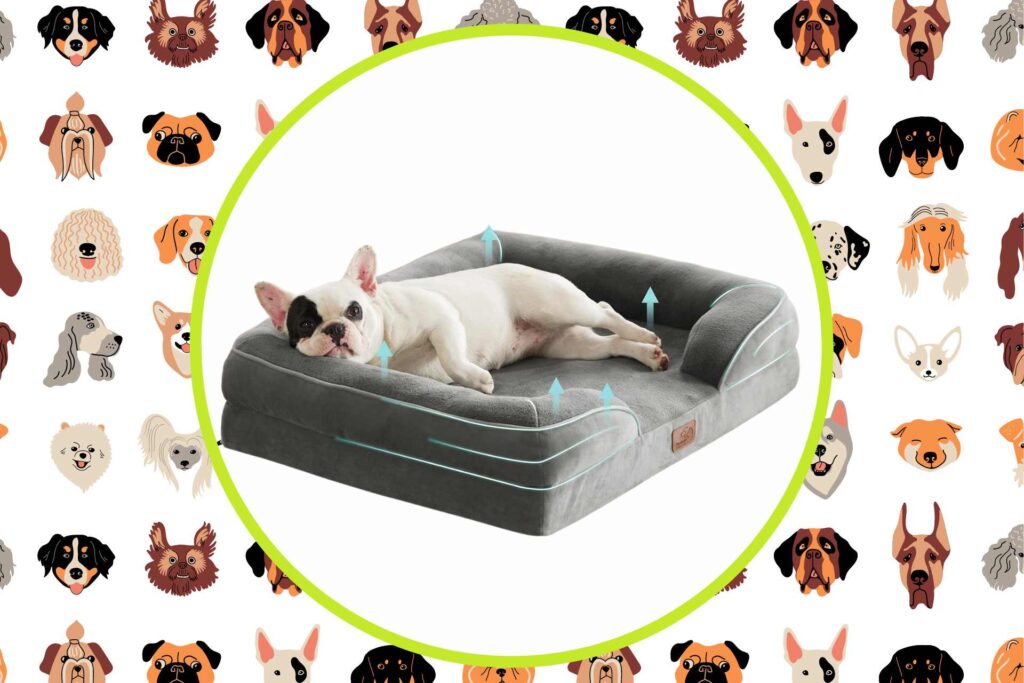Dogs exhibit a common behavior of scratching before they settle down, and it can be intriguing to observe.
In this article I wan’t to answer the question Why Do Dogs Scratch Before They Lay Down?
This scratching stems from both instinctual behavior and comfort preferences. In the wild, dogs would scratch the ground to create a comfortable resting area and to check for any potential threats.
Additionally, scratching helps to mark territory through the scent glands in their paws. This action reassures them that the space they are about to occupy is familiar and safe. Understanding this behavior provides insight into a dog’s natural instincts and can enhance the bond between dogs and their owners.
Understanding Canine Behavior
Canine behavior is shaped by a combination of innate instincts and learned experiences. Factors such as ancestral traits, territorial marking, comfort needs, and emotional responses contribute to why dogs scratch before settling down.
Innate Instincts and Ancestral Behaviors
Dogs exhibit scratching behaviors rooted in their wild ancestors, particularly wolves. In the wild, they would scratch the ground to create a comfortable nest, clearing debris and establishing a resting place. This instinct remains in domestic dogs, even though their environments have changed.
Scratching also helps dogs assess their surroundings. By disturbing the ground, they might uncover scents that indicate safety or potential threats. Thus, this behavior serves a dual purpose: preparing their space and gathering sensory information.
Territorial Marking and Scent Glands
Territorial behavior is significant in canine scratching. Dogs have scent glands in their paws, and scratching allows them to leave their mark in an area. This action communicates to other animals that the space is claimed, which can deter intruders.
Through this behavior, dogs engage in a subtle version of expressing ownership. They may scratch vigorously to reinforce their presence, establishing a sense of security in their chosen resting location. This helps create a peaceful environment for their relaxation.
Safety and Comfort in Bedding
When dogs scratch before lying down, they are also seeking comfort. Scratching can flatten and arrange bedding materials, making the area more suitable for resting. This instinctual action is particularly observed in dogs with bedding items like blankets or beds.
Creating a comfortable nest can enhance their sense of safety. By ensuring their resting space is just right, dogs can relax more easily. This behavior shows an understanding of their need for both comfort and security.
Stress and Anxiety Relief
Scratching can be a method for dogs to relieve stress or anxiety. Dogs often scratch when they are unsettled or nervous about their environment. This action provides a form of self-soothing, helping them feel more in control.
In cases of anxiety, such as changes in surroundings or routine, scratching may increase as dogs attempt to create a calming zone. The rhythmic nature of scratching can serve as a distraction, helping to ease their emotional state and promote tranquility.
The Science of Scratching and Digging
Dogs engage in scratching and digging behaviors for several reasons that relate to their instincts and needs. Understanding these reasons can clarify why this behavior is common before lying down.
Temperature Regulation and Nesting
One primary reason dogs scratch is for temperature regulation. Scratching at surfaces can help create a more comfortable, cooler spot on warmer days or a warmer nest on colder nights. This instinct can be traced back to their wild ancestors who would dig into the earth to find a suitable temperature for comfort.
Nesting behavior also plays a significant role. When preparing to rest, dogs may scratch to form a nest-like area. This behavior helps them create a space that feels safe and secure. It can involve moving bedding or making a slight indentation in the ground or on their dog bed.
Exercise and Energy Expenditure
Digging and scratching can serve as a form of exercise, allowing dogs to expend energy. Dogs, particularly younger ones or those with high energy levels, may scratch repeatedly as a way to engage their muscles and maintain physical fitness. This behavior contributes to their overall health and well-being.
Moreover, scratching helps to stimulate the dog mentally. Engaging in this instinctual behavior can alleviate boredom and reduce the likelihood of destructive actions. The act of digging, even if just on a bed, also reinforces a connection to their ancestral survival skills.
Health and Grooming Considerations
Health factors may also contribute to scratching behavior. Dogs may scratch if they experience discomfort from their paws, such as irritation from poorly trimmed nails or issues with their paw pads. Regular grooming and nail trimming are essential to prevent pain, which may lead to excessive scratching.
Additionally, skin irritations or conditions can cause dogs to dig and scratch more vigorously. If a dog exhibits persistent scratching or digging, it may indicate allergies, fleas, or other health problems. Monitoring these behaviors is important for maintaining a dog’s health and comfort.
Canine Beds and Sleeping Habits
Dogs have specific preferences when it comes to their sleeping arrangements. Understanding those preferences can enhance their comfort and improve their overall well-being. This section discusses how to choose the right bed, establish bedtime rituals, and maintain sleeping areas for optimal canine rest.
- Orthopedic Support: Our orthopedic dog sofa is designed to give your pet unparalleled support for a deep, dreamy sleep. High-density egg-crate foam helps distribute weight evenly and provides the perfect amount of pressure relief and joint support.
- Enhanced Comfort: The 4-sided bolster design promotes ultimate comfort and security, offering your pet a variety of cozy positions to snuggle. The cushioned bolster shape is deeply filled to support your pet’s head and neck for a more restful sleep. And the lowered entrance protects your pet’s knees and promotes accessibility.
- Waterproof & Easy Care: The durable foam mattress is encased in a waterproof liner to fully protect the foam from spills, water damage, or accidents. Remove the zippered cover in seconds and machine wash for easy care.
- Tested & Dog Approved: This supportive dog bed is wrapped in our velvety soft flannel fabric, offering soothing comfort that your furry friend will find cozy and relaxing.
- Pet Safe Materials: This standard 100 by OEKO-TEX certified dog bed consists of CertiPUR-US certified foam and luxurious flannel, creating a safe and comfortable space for your furry friend to rest and recharge. The non-skid bottom reduces slips and protects your dog.
This page contains Amazon.com affiliate links, which means I may earn a small commission should you buy a product featured on this page. At no extra cost to you.
Choosing the Right Bed
Selecting the appropriate bed for a dog is essential. Factors like size, breed, and sleeping style play significant roles. For larger breeds, a spacious bed is crucial, while smaller dogs may prefer a snug fit.
Materials also matter. Memory foam can provide superior support, while orthopedic beds cater to aging pets. Fabrics should be durable and easy to clean, as dogs shed and may have accidents. Investing in a high-quality bed can lead to improved sleep quality.
Bedtime Rituals and Settling Down
Bedtime rituals can help a dog relax before sleep. These practices may include gentle cuddling, soft music, or a favorite toy. Establishing a consistent routine helps signal to the dog that it is time to settle.
Dogs scratching their beds is a common behavior, as it mimics instincts rooted in their wild ancestry. This action helps them make their sleeping area more comfortable, creating a cozy nest. Providing blankets or cushions that they can rearrange can enhance their nighttime comfort.
Maintenance of Sleeping Areas
Keeping the sleeping area clean is vital for a dog’s health. Regularly washing bedding can prevent the buildup of dander and bacteria. It is best to use pet-safe detergent that is free from harsh chemicals.
Vacuuming the surrounding area will eliminate dirt and hair, enhancing the dog’s space. Additionally, rotating or replacing toys in their sleeping area can keep the environment stimulating. Providing a comfortable and hygienic sleeping space fosters better sleep patterns for dogs.
Behavioral Aspects of Scratching
Scratching before lying down serves multiple functions rooted in a dog’s behavioral instincts. These behaviors are influenced by communication, curiosity, and even potential concerns related to obsessive tendencies.
Communication and Pack Hierarchy
Dogs use scratching as a form of communication, signaling their presence to others. This behavior can establish their place within pack dynamics. By scratching, a dog marks its territory using scent glands located in its paws.
This instinctual action also indicates to other pack members that they are secure in their chosen resting spot. In domesticated settings, this behavior may manifest differently due to the absence of natural dangers like predators. Nevertheless, the impulse to assert territory remains strong.
Curiosity and Exploratory Behavior
Dogs are inherently curious animals. Scratching can indicate an exploratory instinct, as they investigate the texture and scent of the ground.
In the wild, dogs often engaged in behaviors similar to scratching to inspect their surroundings and ensure their safety from potential threats. This instinct is still prevalent in domesticated dogs, where they may scratch to uncover hidden smells or identify any disturbances in their environment.
Such behavior doesn’t only serve to prepare a comfortable space but also stimulates their acute sense of smell and promotes mental engagement.
Obsessive Behaviors and Potential Concerns
While scratching is typically a normal behavior, it can lead to obsessive tendencies in some dogs. This obsession may stem from anxiety or stress, such as separation anxiety or boredom.
Experts suggest monitoring this behavior, especially if it becomes excessive. Prolonged scratching can harm the skin, leading to irritation or infection.
Identifying the root cause of excessive scratching is important, as it can be linked to underlying health issues or changes in the dog’s environment. Ensuring mental stimulation and a secure environment can help alleviate these concerns.
Practical Tips for Dog Owners
Understanding scratching behaviors in dogs is critical for their comfort and well-being. Implementing practical strategies can help manage these behaviors and create a better sleeping environment for pets.
Reducing Unwanted Scratching Behavior
To minimize undesirable scratching, training is essential. Positive reinforcement techniques can effectively discourage excessive scratching. For instance, rewarding a dog for laying down promptly without scratching promotes a more desirable behavior.
Setting boundaries can also be beneficial. Designate specific areas for your dog to rest, ensuring they feel secure and comfortable. Encouraging them to stay in these areas reduces the urge to scratch or dig before lying down.
Engaging in regular exercise can help alleviate pent-up energy, which may contribute to scratching. Ensuring that dogs receive adequate physical and mental stimulation reduces unwanted behaviors.
Creating a Comfortable Sleep Environment
Comfort is crucial for a good night’s sleep. Ensuring that the dog’s bed is cozy and appropriate for their size can help improve their sleep quality. Using high-quality, washable bedding can prevent odor buildup and maintain hygiene.
Temperature control plays a key role. Providing adequate warmth during colder months, but ensuring ventilation in warmer temperatures is essential. Dogs often scratch to adjust their sleeping environment, so making it more comfortable can alleviate this behavior.
Incorporating familiar items, such as a blanket or a toy, can create a sense of security. This practice can assist them in settling down more quickly and reduce unnecessary scratching.
Addressing Underlying Health Issues
If a dog displays persistent scratching, it may indicate an underlying health problem. Common issues include allergies, skin irritations, or parasites. Regular veterinary check-ups can help identify and address these conditions early.
Paying attention to the dog’s diet is also important. A balanced diet that supports skin health can minimize irritation. Consulting with a veterinarian regarding specialized diets may help if allergies are suspected.
Observing changes in scratching patterns is crucial. If scratching occurs at specific times or in certain environments, it may be helpful to keep a diary of these occurrences. This information can aid a veterinarian in diagnosing potential health concerns.
Frequently Asked Questions
Many dog owners notice their pets engaging in scratching behavior before settling down. This can raise various questions about the reasons behind this common habit.
Why do dogs dig at their sleeping spots?
Dogs dig at their sleeping spots due to instinctual behaviors. This action can mimic natural practices seen in wild canines that create a comfortable area or tunnel for shelter.
What causes dogs to scratch their beds before they sleep?
Scratching can be a way for dogs to prepare a cozy resting area. It helps them to mark their territory, as they have scent glands in their paws, and it may trigger a sense of security.
Is it normal for dogs to dig on couches and beds?
Yes, it is normal for dogs to dig on furniture. This behavior can stem from their instinct to create a comfortable area for lying down, similar to how they would act in the wild.
What does it mean when a dog suddenly starts scratching the bed?
A sudden change in scratching behavior might indicate stress, discomfort, or health issues. Observing other signs can help determine if there is an underlying cause that requires attention.
Can the behavior of a female dog digging in bed be explained?
Female dogs may dig in bed for reasons related to nesting instincts, especially if they are in heat or pregnant. This behavior can provide them a sense of comfort and security.
What triggers dogs to scratch the floor or carpet in the home?
Dogs may scratch the floor or carpet for various reasons, such as boredom, anxiety, or the urge to create a comfortable spot. It can also be a way to express their need for attention or play.
Bedsure Orthopedic Bed for Medium Dogs Review: Is It Worth Your Investment?

The Bedsure Orthopedic Bed for Medium Dogs stands out as a superior choice for pet owners who prioritize their dog’s health and comfort. With its high-density egg-crate foam, the bed offers unmatched orthopedic support, ensuring even weight distribution and joint support critical for medium-sized dogs.
Continue reading: Bedsure Orthopedic Bed for Medium Dogs Review
Creating a Sleep Routine for Dogs: A Comprehensive Guide to Better Nights

Creating a consistent sleep routine for dogs is akin to setting a strong foundation for their health and happiness. Just as humans benefit from a regular sleep schedule, dogs, too, find comfort and security in predictability.
This regularity significantly diminishes their anxiety, making them more relaxed and amenable to training. Moreover, a stable sleep routine directly impacts a dog’s temperament, leading to improved behavior and a reduction in sleep-related issues such as insomnia or excessive nocturnal activity.
Continue reading: Creating a Sleep Routine for Dogs





